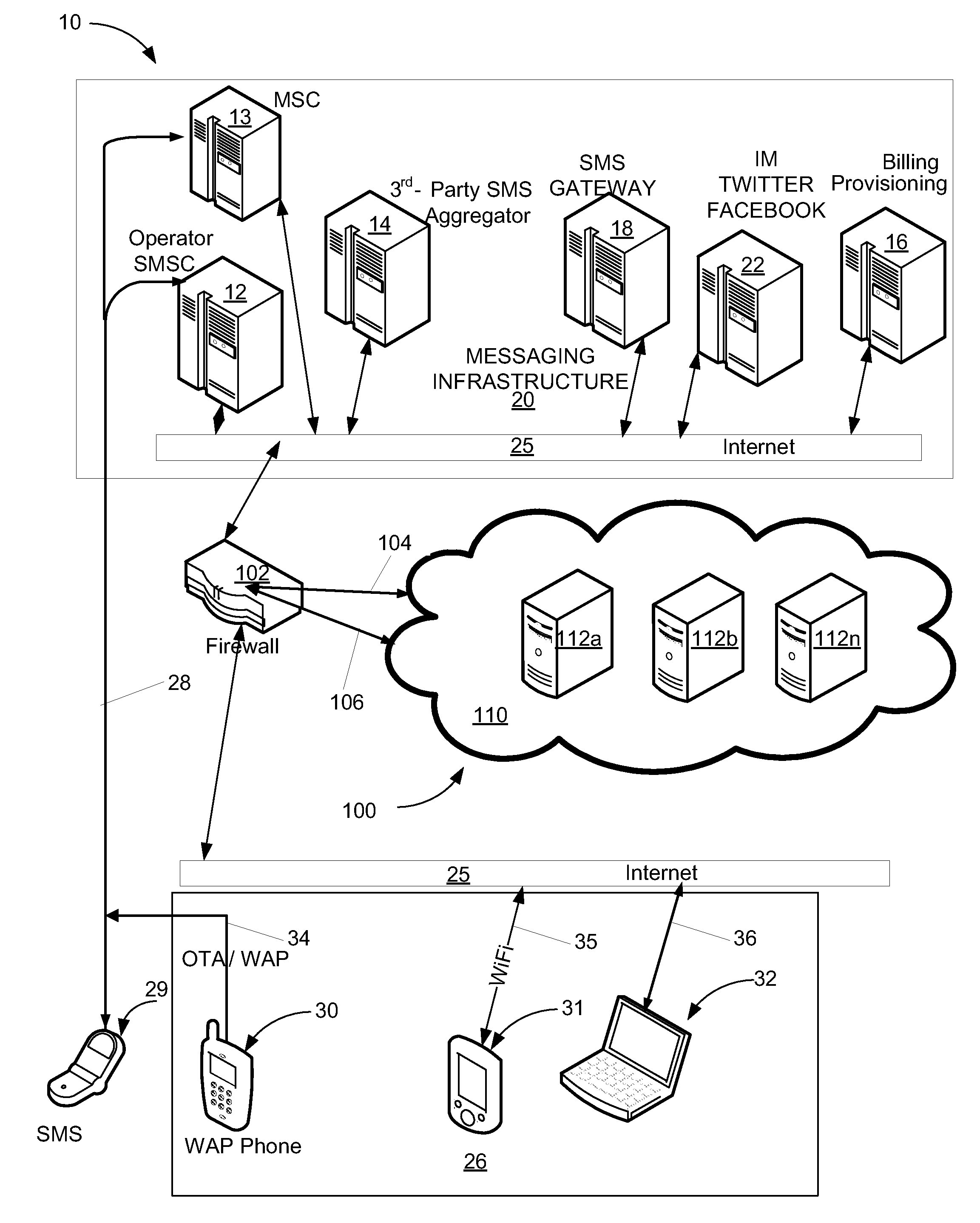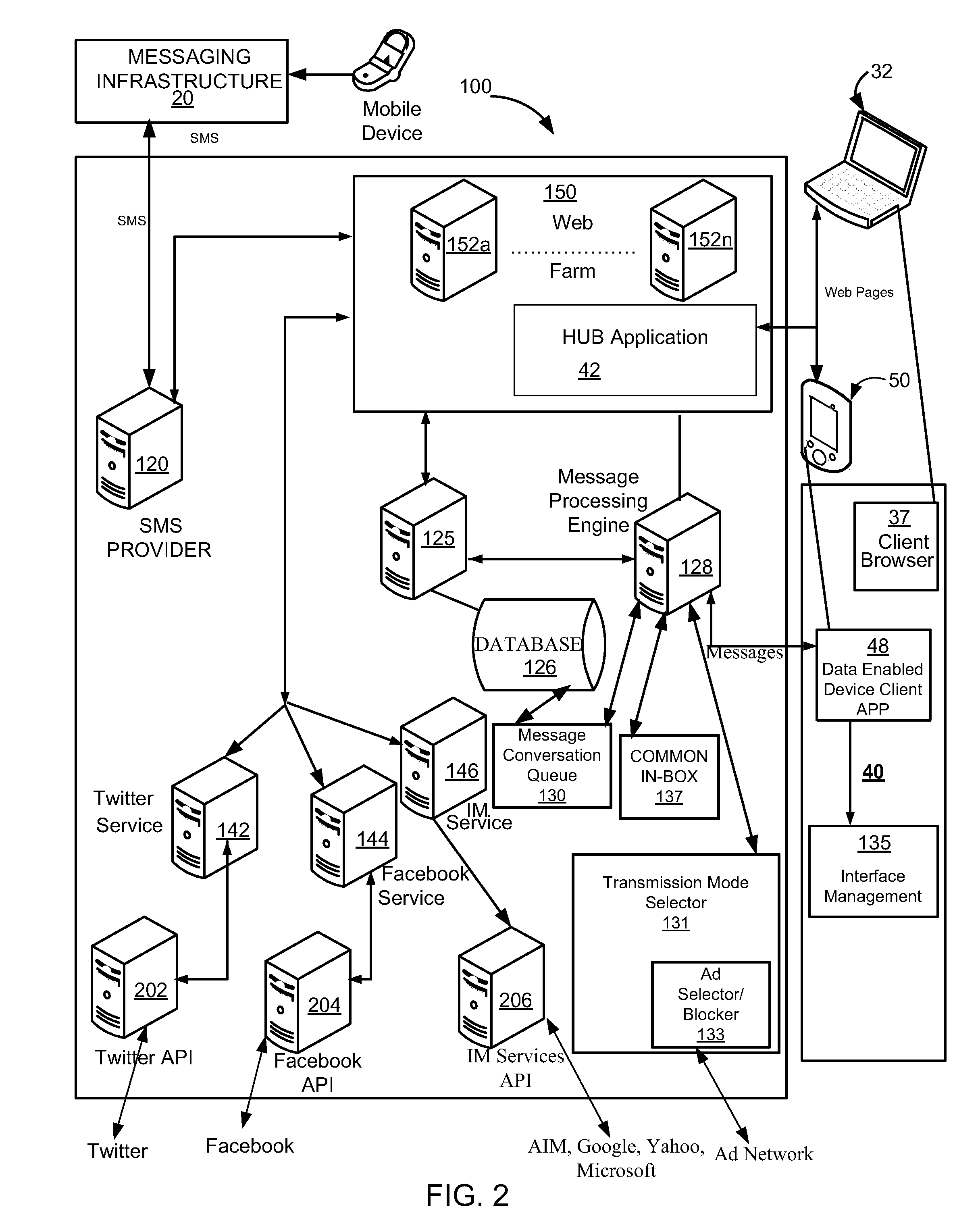[0009]Such a technique, overcomes the limitations of carrier networks and international boundaries. Significantly, this technique provides a
telephone number to the user, thus invoking many of the legal rights enjoyed by telephone subscribers in the user's jurisdiction. The service may appeal especially to parents who do not want their children to have mobile phones, but understand the value of texting and other messaging for the child's social life, enabling communications and educational development; or who wish to have each family member in a family plan service, but without the high costs associated with full
mobile telephony plans. In this case, the virtual phone number may be viewed as a placeholder for later telephone service, for example when the child graduates beyond elementary school. From the provider perspective, because the use of a virtual phone number for addressing SMS / MMS / EMS messages neither requires nor involves the extensive tracking and routing infrastructure that supports mobile voice calling, but can be supported by a simple web-based
server network, they may offer virtual number messaging services at attractive and affordable rates without incurring incremental capital requirements.
[0010]Indeed, all subscriber messages are transmitted over
the Internet through one or more servers and a
message aggregation entity in the messaging infrastructure, so the entire service may be set up as a small
third party or outside NUVO, or as similarly small Internet-coupled
server operation within an existing
mobile carrier (or land-line) network. When offered by an existing
mobile carrier to a subscriber with an existing
mobile phone, the
system enables a user to additionally log onto a web-based service to send and receive SMS / MMS messages with his PC or other data enabled device. Such a web-based service may also operate to send and receive messages identified by a user's land line phone number, even if the user's land line / fixed phone is not SMS / MMS / EMS capable. The social messaging hub may be configured to exchange user messages with common messaging entities, such as
Microsoft Windows Live Messenger, AIM, Yahoo, GoogleTalk™, Twitter, Facebook and others, so that texting mobile phones and non-
telephony data devices can enjoy substantially similar messaging capabilities. When offered by an existing
mobile carrier to a subscriber with an existing
mobile phone, the
system enables a user to additionally use a secondary phone number simultaneously with his primary phone number to send and receive SMS / MMS / EMS messages with his
mobile phone, in essence providing a duality of identifications on a single device.
[0013]A data enabled device (also referred to as the Wi-Fi /
mobile device) having
dual mode Internet network access capabilities operates with
software to optimize cost and to efficiently display content or effect communications when traveling internationally away from a home locale or when using a limited
data transmission plan. Internal
software controls SMS transmission so as to minimize international
text messaging charges, and preferably also establishes Internet connection via Wi-Fi connection for accessing content, such as advertising content, appearing on the device's display. For use in a
foreign country, the device may be fitted with a SIM card of the
foreign country carrier (a local SIM card) and operate as a normal mobile phone to receive local calls, while it is configured to automatically send SMS messages via Wi-Fi, or using data capabilities associated with the data local SIM card when Wi-Fi
connectivity is unavailable.
[0015]Such a
system enables the user to utilize multiple country or domestic telephone numbers (identities) on same account,
software client and a single device. In addition, because the technique is IP-based in network technology, it is geographically independent of country borders (operate globally without consideration to factors such as
roaming). This technique reduces costs to users and enables geographic independence.
[0016]The ability to utilize multiple telephone numbers and / or IP based address accounts on a single account / software / hardware device without having to setup or utilize different account / software clients / hardware device, including dual / multiple SIM devices while reducing message, transmission and data charges is desirable. In one embodiment, a technique for selecting a
wireless device mode of transmission includes communicating with a messaging hub, determining an identity of the
wireless device, determining a location of the wireless device and determining a mode of transmission to reduce transmission charges. The technique further includes determining a destination of an SMS message and notifying the messaging hub to
delay sending advertising content. Such a technique can reduce the costs associated with sending and receiving SMS text messages.
 Login to View More
Login to View More  Login to View More
Login to View More 


